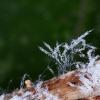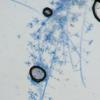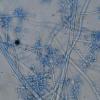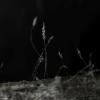
24-12-2025 17:08
Hulda Caroline HolteHello, I have found this propoloid ascomycete on

21-12-2025 09:32
Hello.A tiny ascomycete found embedded in wood in

21-12-2025 21:32
Pol DebaenstHello, Garden, Burgweg 19, Veurne, BelgiumOn 10/1

22-12-2025 23:38
Patrice TANCHAUDBonsoir, récolte sur un mur en pierre, apothéci

22-12-2025 00:47
Patrice TANCHAUDBonsoir, récolte à proximité du milieu dunaire
Botryosporium longibrachiatum
Stephen Martin Mifsud,
20-09-2020 22:01
 I have found Botryosporium longibrachiatum on decaying leaves of Acanthus mollis in the wild here in Malta and maybe it is a new host for this fungus. Apparently it is recorded on different hosts. I had difficulty to distinguish from B. pulchrum but according to Zhang Tian-yu & B Kendrick (Mycosystema, 1990), pulchrum should have dichotomously branched conidiophores. I am not sure how much reliable is this charachteristic or otherwise most images on the net of pulchrum are longibrachiatum.
I have found Botryosporium longibrachiatum on decaying leaves of Acanthus mollis in the wild here in Malta and maybe it is a new host for this fungus. Apparently it is recorded on different hosts. I had difficulty to distinguish from B. pulchrum but according to Zhang Tian-yu & B Kendrick (Mycosystema, 1990), pulchrum should have dichotomously branched conidiophores. I am not sure how much reliable is this charachteristic or otherwise most images on the net of pulchrum are longibrachiatum.The conidiophores were septate, with occassional wart-like projections, up to 4 mm long, c. 10um wide lateral vesicle branches patent, 75-100um long including vesicle, narrowing at the base, vesicle rhomboid or biconic 12-15um long and 1bout 10um diameter; ampullae 2-4 lobed with globose-clabate heads bearing few dozens of conidia, leaving behind a small peg when shed. Conidia fusiform-ellipsoid, 5-7um long, smooth, hyaline, stains good in cotton blue.
I was thinking that the conidiophore 'stalk' must be very strong being only 8-10um thich and have to hold erect that huge mass of many vessicles and spores along a 2000-3000um long conidiophore





 ConidioSpores c. 6um long
ConidioSpores c. 6um long